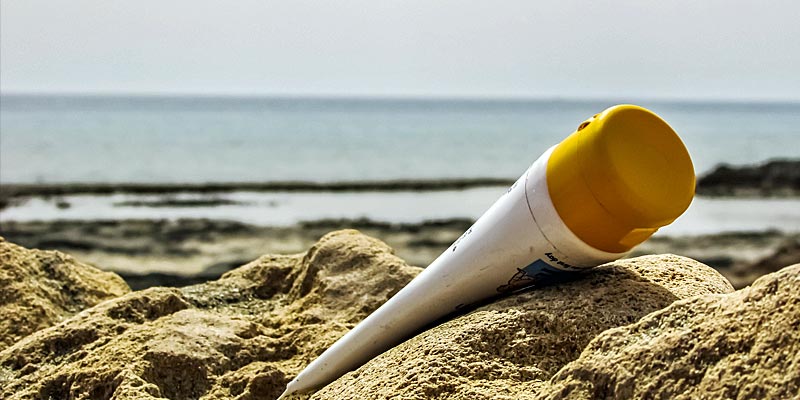
Summer is alive and kicking here in New Zealand and whilst we love the warmth and the feel good factor that the sunshine brings, we all know that our exposure to it demands careful respect – this is where a natural sunscreen can help!!
The sun is particularly strong in New Zealand; UV levels are around 40% higher than similar latitudes in North America. This is due to a number of environmental factors; a depleted ozone layer and lower levels of air pollution allow the UV radiation to pass through easily, and the sun is closer to the earth in December and January meaning we are physically nearer to the sun in New Zealand than other parts of the world.
Increased or prolonged exposure to the sun and its UV radiation causes skin damage (sun burn) and is responsible for around 90% of skin cancer. New Zealand has the highest incidence of melanoma in the world with over 300 Kiwi’s dying of melanoma every year.
Sunscreens and SPFs
Being sun safe, or sun smart is easy – covering up or staying in the shade are the most reliable ways to avoid exposure. But, we don’t want to spend the entire summer in the shade do we…?? That is where sunscreens come in.
Sunscreens are creams or lotions that deflect or absorb sunlight after being applied to our skin. The effectiveness or strength of a sunscreen is measured in SPF which means Sun Protection Factor. The SPF number is the fraction of UV rays that will reach the skin. For example, an SPF 30 sunscreen will allow 1/30th or 3.3% of the sun’s rays to reach the skin. Another way to think of this is that if your skin were to burn in 10 minutes, using an SPF 30 sunscreen would extend that burn time to 30 times that: 300 minutes. But these numbers are not an exact science and depend on the condition of your skin to start with and how thoroughly and properly applied the sunscreen is.

UVA and UVB
The sun’s rays carry both UVA and UVB radiation. UVA radiation goes deep into the dermis layer of the skin. It can age the skin and cause long term damage like wrinkles. And as it doesn’t burn us, there’s no indicator that we’ve been overexposed. UVA radiation is also proven to contribute to the development of skin cancer.
UVB radiation doesn’t penetrate the skin so deeply but it’s this radiation that burns the skin. The ozone layer absorbs most of the UVB rays but as we mentioned earlier, a depleted ozone layer means more of this type of radiation is reaching earth.
Sunscreens used to be primarily about UVB protection and SPFs are a measure of protection against UVB rays, not UVA rays. So, as well as the SPF it’s important to look for what’s called a ‘broad spectrum’ sunscreen which offers protection against both UVA and UVB radiation.
Mineral vs Chemical
There are two main types of sunscreen; those that reflect the sun’s rays and those that absorb them. A natural sunscreen tends to be a mineral or ‘reflector’ sunscreen which contains metals like zinc oxide or titanium dioxide as the active ingredients. The tiny particles of metal act like mirrors and literally reflect the rays away from the skin. Zinc oxide is thought to be an effective broad spectrum sunscreen giving protection against UVA and UVB radiation.
It’s important to remember though that not all mineral sunscreens would be considered a natural sunscreen or perfectly safe. Check that the other ingredients are familiar to you and avoid the potentially harmful yet commonly used synthetic preservatives and perfumes. For a reminder about why we should care about this stuff and what chemicals to avoid, read why natural beauty is better for you.
The absorbers are the sunscreens we usually find on the supermarket shelves which can contain an array of chemicals including oxybenzone, octinoxate, homosalate, octisalate and octocrylene. These chemicals absorb the suns radiation and convert it to a very low level of heat which is released into the air. However, some of these chemicals have been linked to harmful side effects and so are best treated with caution.
The Nasties
During summertime especially, we can be applying and re-applying sunscreens to our skin daily. We’ve talked before about the risks of certain chemicals that come ‘hidden’ in our skincare and how they can be absorbed into our bodies after we rub them all over our skin. And sunscreen is no different. The Environmental Working Group (EWG) advise that oxybenzone and octinoxate are both absorbed though our skin and act as endocrine disruptors affecting our reproductive systems. They have also been shown to cause skin allergies and the EWG’s recommendation is that we avoid sunscreens that contain oxybenzone.
Vitamin A (also known as retinyl palmiate or retinol) is another commonly used ingredient in sunscreens. Whilst it is not toxic (indeed, it is good for us when consumed as part of our diet) it is sensitive to sunlight. When exposed to sunlight, vitamin A may actually increase the chances of developing skin cancer, skin damage and premature ageing so the EWG also advise to avoid this.
Whilst we have covered some of the most common and problematic ingredients in sunscreens, if you are at all concerned about anything else in your current sunscreen, even if it’s a natural sunscreen, we recommend doing some further research.

Vitamin D
We can’t talk sunshine without mentioning vitamin D. Being in the sun is how our bodies get most of the vitamin D that they need. So, whilst the risks of prolonged exposure to sunlight are very real, SOME exposure is sensible. Vitamin D is essential for strong bones and a healthy immune system and overuse of strong sunscreens and avoiding the sun altogether can lead to a vitamin D deficiency – another prevalent condition in New Zealand.
The challenge for all of us is to get enough vitamin D without dangerously over exposing our skin to the sun.
During summer time, the sun is at its strongest between 10am and 4pm so using sun protection during these times is recommended. But outside of these times, a short walk or perhaps breakfast in the sun is a great way to get your daily dose of vitamin D.

So What’s Important When Choosing Natural Sunscreen…??
As we have seen, there is a lot to consider when choosing a sunscreen and being sun smart. So here are our top tips to help you next time you’re buying natural sunscreen:
- Avoid sunscreen, including “natural sunscreen”, that contains oxybenzone or octinoxate.
- As with other skincare products, choose sunscreens that do not contain preservatives like parabens or methylisothiazolinone, artificial perfumes or fragrance, petrolatum or mineral oil.
- Avoid sunscreen containing Vitamin A.
- A natural sunscreen containing zinc oxide or titanium dioxide is a good start.
- Choose a sunscreen with a minimum SPF 30.




